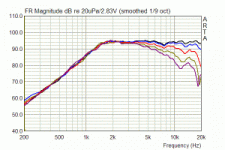Monacor DT 25 N, dome tweeter (priced currently around 30.- Euros):
Test Monacor DT-25N
See above link e.g. for cumulative spectral decay.
1st attachment, frequency response under angles
Test Monacor DT-25N
See above link e.g. for cumulative spectral decay.
1st attachment, frequency response under angles
Attachments
Last edited:
One main difference between Manger design on the one hand and "BMR" (but also "DDD"/Walsh) approach on the other hand is Manger's design using a rather thin and less stiff membrane material, providing a phase speed of bending waves that is "lower than sound in air" in the audible spectrum (high coincidence frequency of membrane).
This causes a kind of "compensation" in pressure between zones in the nearfield of the membrane radiating in antiphase due to modal behaviour:
The "pistonic part" of motion is accentuated, so to speak, when comparing to a "faster" material in radiation. Furthermore a high grade of damping is applied especially towards the outer zones of the membrane.
To cut a long story short: Manger is a bending wave design, but radiation is pretty much "beaming in highs" similar to traditional pistonic acting drivers.
Designs - also more recent ones - using more rigid membranes, may achieve a decorrelated radiation pattern in highs, as soon as the coincidence frequency of the membrane is reached, which is within the audible range with these designs.
This way a more constant energy response may be achieved, especially at the upper end.
The art in making acceptable - if not high - quality bending wave designs having more rigid membranes is having the modes of the membrane "inaudible" and the on axis response smooth, which can only be achieved by having sufficiently modal overlap and also damping.
The modal overlap factor however is with most "rigid" bending wave membranes far below the modal overlap of high grade musical instruments e.g.
In the Manger design single modes up to e.g. 1Khz are even visible in the impedance plot of the driver. In case of Manger's design, it is the "slower than sound in air" propagation of bending waves, which contributes in making those modes in midrange - more or less - inaudible.
Unfortunately also peaks in K2, K3 distorsion are correlated with modes detectable in the impedance, which suggest "higher than usual" crossover frequencies than realized with some boxed designs proposed using a Manger driver: Crossing over well above 500Hz - having sufficient steepness of the highpass - seems adviseable and if one wants the driver working "kind of flawless" even crossing >2Khz was an option. But then we already have serious competition by more recent and specialized tweeter designs ...
Kind Regards
This causes a kind of "compensation" in pressure between zones in the nearfield of the membrane radiating in antiphase due to modal behaviour:
The "pistonic part" of motion is accentuated, so to speak, when comparing to a "faster" material in radiation. Furthermore a high grade of damping is applied especially towards the outer zones of the membrane.
To cut a long story short: Manger is a bending wave design, but radiation is pretty much "beaming in highs" similar to traditional pistonic acting drivers.
Designs - also more recent ones - using more rigid membranes, may achieve a decorrelated radiation pattern in highs, as soon as the coincidence frequency of the membrane is reached, which is within the audible range with these designs.
This way a more constant energy response may be achieved, especially at the upper end.
The art in making acceptable - if not high - quality bending wave designs having more rigid membranes is having the modes of the membrane "inaudible" and the on axis response smooth, which can only be achieved by having sufficiently modal overlap and also damping.
The modal overlap factor however is with most "rigid" bending wave membranes far below the modal overlap of high grade musical instruments e.g.
In the Manger design single modes up to e.g. 1Khz are even visible in the impedance plot of the driver. In case of Manger's design, it is the "slower than sound in air" propagation of bending waves, which contributes in making those modes in midrange - more or less - inaudible.
Unfortunately also peaks in K2, K3 distorsion are correlated with modes detectable in the impedance, which suggest "higher than usual" crossover frequencies than realized with some boxed designs proposed using a Manger driver: Crossing over well above 500Hz - having sufficient steepness of the highpass - seems adviseable and if one wants the driver working "kind of flawless" even crossing >2Khz was an option. But then we already have serious competition by more recent and specialized tweeter designs ...
Kind Regards
Last edited:
- Status
- This old topic is closed. If you want to reopen this topic, contact a moderator using the "Report Post" button.
